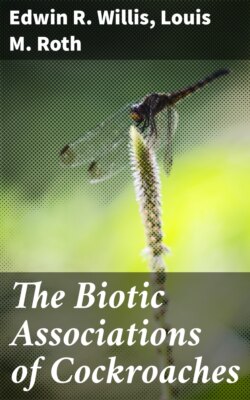Читать книгу The Biotic Associations of Cockroaches - Edwin R. Willis - Страница 224
На сайте Литреса книга снята с продажи.
Eurycotis floridana
ОглавлениеFlorida.—Moderately common under bark of dead pine stumps and logs; at Key West it fairly swarmed under coquina boulders in the woods (Rehn and Hebard, 1905). Many specimens under palmetto leaves on ground (Caudell, 1905). In pine woods under dry bark of dead logs; on Long Key in dry fibers at the base of the heads of coconut palms; "at Key West, a large colony was discovered among boards lying on dry grass in a field, and several were captured upon turning over coquina boulders in the dense bush" (Rehn and Hebard, 1912). Particularly numerous in tree cavities and under bark along the edge of hammock areas (Hebard, 1915). Abundant between basal leaves of Tillandsia utriculata; beneath loose bark of logs and stumps; in and beneath decaying palmetto trunks and leaves; under rubbish (Blatchley, 1920). On ground in heavy tangle after dark; in decaying log of Sabal palmetto; in bromeliads; common under debris and bark in jungle; under signs on Pinus caribaea; in almost every sheltered outdoor place (Hebard, 1917). It moves about at night and hides under bark of logs and in other recesses during the day; where pines are present it almost invariably hides under bark of dead logs and stumps (Rehn and Hebard, 1914). Friauf (1953) found this species in leaf duff, leaf mold, or decaying wood in these habitats: Sandhills (infrequent), xeric hammock (dominant), mesic hammock (frequent), and low hammock (dominant); on tree trunks in sandhills habitat (infrequent) and mesic hammock (frequent); infrequent in saw-grass marsh habitat in the grass stratum and, during the dry season, in decaying vegetation on floor of marsh. Under the bark of logs and beneath logs in the woodpile habitat (Friauf, 1953).
